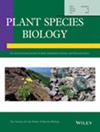Population genetics of Zamia decumbens (Zamiaceae, Cycadales), an endangered cycad from the Maya Mountains of Belize
IF 1.3
4区 生物学
Q4 ECOLOGY
引用次数: 0
Abstract
We utilized 10 microsatellite loci to examine the genetic diversity, genetic structure, and demographic history of伯利兹玛雅山脉濒危苏铁植物 Zamia decumbens(苏铁科,Zamiaceae)的种群遗传学
我们利用 10 个微卫星位点研究了 Zamia decumbens Calonje、Meerman、M.P. Griff. & Hoese 的遗传多样性、遗传结构和人口历史。我们在两种不同的生境中采集了四个种群的样本:三个在岩洞内(一个在洞口,两个在天坑底部),一个在岩石山顶。该物种的基因变异反映了采样种群的人口历史,而这一历史似乎与石灰岩基岩的岩溶化密切相关,而不是按地理或栖息地类型划分的。当代种群之间的基因流动较少,洞穴种群作为其他种群的迁徙源,促进了该地区大部分基因的连接。基于聚合的建模显示,两个天坑种群是最早建立的,而山顶和洞穴种群是最近从一个共同的祖先种群建立的。所有种群都处于哈代-温伯格平衡和中等杂合状态,但在洞穴种群中发现了近期瓶颈事件的特征。此外,山顶种群的近交系数较高,平均配对亲缘关系也较高,后者可能是近期非法采伐活动的结果。
本文章由计算机程序翻译,如有差异,请以英文原文为准。
求助全文
约1分钟内获得全文
求助全文
来源期刊

Plant Species Biology
生物-生态学
CiteScore
2.70
自引率
14.30%
发文量
36
审稿时长
>12 weeks
期刊介绍:
Plant Species Biology is published four times a year by The Society for the Study of Species Biology. Plant Species Biology publishes research manuscripts in the fields of population biology, pollination biology, evolutionary ecology, biosystematics, co-evolution, and any other related fields in biology. In addition to full length papers, the journal also includes short research papers as notes and comments. Invited articles may be accepted or occasion at the request of the Editorial Board. Manuscripts should contain new results of empirical and/or theoretical investigations concerning facts, processes, mechanisms or concepts of evolutionary as well as biological phenomena. Papers that are purely descriptive are not suitable for this journal. Notes & comments of the following contents will not be accepted for publication: Development of DNA markers. The journal is introducing ''Life history monographs of Japanese plant species''. The journal is dedicated to minimizing the time between submission, review and publication and to providing a high quality forum for original research in Plant Species Biology.
 求助内容:
求助内容: 应助结果提醒方式:
应助结果提醒方式:


